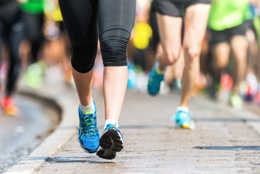25 September 2015
 A new 3D gait laboratory at UniSA is helping to create the next generation of athletic footwear in an exciting industry collaboration with running shoes giant ASICS.
A new 3D gait laboratory at UniSA is helping to create the next generation of athletic footwear in an exciting industry collaboration with running shoes giant ASICS.
The ARENA Gait and Performance (GAP) Laboratory aims to push the boundaries of footwear design and athletic performance, and develop the super-advanced sneaker of tomorrow.
Research Fellow Chris Bishop says the high performance research collaboration will ultimately improve running shoe comfort and performance for recreational and elite runners.
“The overall aim of this collaboration is to develop and translate the results we collect in the lab into product design,” Bishop says.
“It’s all about how we can design high tech shoes that will be super comfortable, help improve performance and economy, and reduce injury.”
The new lab, based at the University’s City East campus, features 3D motion analysis and a state-of-the-art treadmill with in-built force measurement capability.
Professor Roger Eston, Head of the School of Health Sciences, welcomes this initiative with ASICs.
“This is really exciting,” Prof Eston says.
“Our collaboration with ASICS fits in beautifully with the School’s intention to grow its successful profile of working with elite sport partners in SA, already spanning a number of sports and including a UniSA partnership with Port Adelaide Football Club and sponsored agreements with Basketball SA and Adelaide United Football Club. The partnerships provide great opportunities for our students and open doors to further enhance UniSA’s world class research record in human movement and sports science.”
Bishop says research will involve innovation and biomechanical testing of ASICS shoes, with particular focus on the effect of dual density midsoles on the foot, and the relationship between speed and footwear requirements in running.
“The movement of the foot inside the shoe has eluded footwear researchers for some time,” Bishop says.
“Being a podiatrist originally, we use orthotics, we tape, we use in-shoe wedging … but once we put the foot inside the shoe it’s a bit of a black box.
“What’ve we’ve been able to do is develop capabilities to describe in-shoe foot motion through state-of-the-art computational modelling. This has provided insights into foot function during walking and running while wearing shoes, the effect of technical footwear design, as well as the mechanisms of action of in-shoe foot orthotics.
“Dual density midsoles are thought to improve comfort and reduce injury for people with flatter feet, but they also add mass to the shoe. We’re looking at all the shoe features and trying to myth bust – what do these features do, do we need them – in an effort to reduce shoe mass.”
As well as being a cutting-edge research environment, the lab will offer private analyses of running mechanics for individuals, groups and sports teams through a collaborative partnership with Bishop’s private practice The Biomechanics Lab. Bishop says his equipment analyses force, and it is force that causes running injuries.
“What sets our lab apart is that we’ve got the type of information to be able to analyse how the body moves and the effect that the footwear is having, but also how different shoes, techniques and interventions alter the forces applied to the body when we run,” he says.
Bishop says his research team is also currently looking to recruit recreational runners for a range of research studies in coming months.
“We’ll need help from local runners in our research that will not only help ASICS design sneakers that are a running game changer, but also help them personally take their running further and faster.”
Runners interested in taking part in the lab’s research or having private analyses can email Christopher.bishop@unisa.edu.au
The ARENA GAP Laboratory continues a long-running research partnership between ASICS and UniSA which began in 2009 and seeks to fill the ‘GAPs’ in the understanding of advanced running shoe design.
ARENA is UniSA’s Alliance for Research in Exercise, Nutrition and Activity. Find out more about ARENA’s research capabilities here.
Media Contact Kelly Stone office (08) 8302 0963 mobile 0417 861 832 email Kelly.stone@unisa.edu.au


